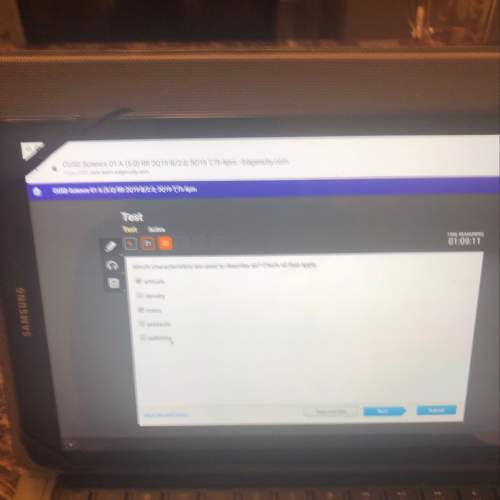
Chemistry, 25.11.2020 14:00 jady20krazy
Plate Tectonics Lab Report
Instructions: In the Plate Tectonic lab you will investigate the interactions between continental and oceanic plates at convergent, divergent, and transform boundaries around the globe. Record your observations in the lab report below. You will submit your completed report.
Name and Title:
Include your name, instructor's name, date, and name of lab.
Kaleb, Ms. Young, 11/25/2020, Plate Tectonics Lab Report
Objective(s):
In your own words, what was the purpose of this lab?
To look at interactions between continental and oceanic plates.
Hypothesis:
In this section, please include the if/then statements you developed during your lab activity for each location on the map. These statements reflect your predicted outcomes for the experiment.
Location One: Select three events that you predict will be observed. If I explore two continental plates at a convergent boundary, then I will observe:
earthquakes
faults
ocean formation
mountains
volcanoes
island chains
seafloor spreading
Location Two: Select three events that you predict will be observed. If I explore two continental plates at a divergent boundary, then I will observe:
earthquakes
faults
ocean formation
mountains
volcanoes
island chains
seafloor spreading
Location Three: Select three events that you predict will be observed. If I explore two continental plates at a transform boundary, then I will observe:
earthquakes
faults
ocean formation
mountains
volcanoes
island chains
seafloor spreading
Location Four: Select two events that you predict will be observed. If I explore two oceanic plates at a convergent boundary, then I will observe:
earthquakes
faults
ocean formation
mountains
volcanoes
island chains
seafloor spreading
Location Five: Select three events that you predict will be observed. If I explore two oceanic plates at a divergent boundary, then I will observe:
earthquakes
faults
ocean formation
mountains
volcanoes
island chains
seafloor spreading
Location Six: Select two events that you predict will be observed. If I explore two oceanic plates at a transform boundary, then I will observe:
earthquakes
faults
ocean formation
mountains
volcanoes
island chains
seafloor spreading
Procedure:
The procedures are listed in your virtual lab. You do not need to repeat them here. Please be sure to identify the test variable (independent variable), outcome variable (dependent variable).
Reminder: Test variable = the item you are changing or manipulating; Outcome variable = the item you are measuring
Test variable (independent variable):
Outcome variable (dependent variable):
Data:
Record the data from each location below.
Location Name
Boundary Type
(C=Convergent, D=Divergent, or T=Transform)
Year Observed
(5, 10, or 20 million years)
Geologic Events Observed
(earthquakes, faults, ocean formation, mountains, volcanoes, island chains, seafloor spreading)
Location One
Himalayas
5
Event 1-
20
Event 2-
Location Two
East Africa
5
Event 1-
earthquakes
faults
ocean formation
mountains
volcanoes
island chains
seafloor spreading
Location Five: Select three events that you predict will be observed. If I explore two oceanic plates at a divergent boundary, then I will observe:
earthquakes
faults
ocean formation
mountains
volcanoes
island chains
seafloor spreading
Location Six: Select two events that you predict will be observed. If I explore two oceanic plates at a transform boundary, then I will observe:
earthquakes
faults
ocean formation
mountains
volcanoes
island chains
seafloor spreading
Procedure:
The procedures are listed in your virtual lab. You do not need to repeat them here. Please be sure to identify the test variable (independent variable), outcome variable (dependent variable).
Reminder: Test variable = the item you are changing or manipulating; Outcome variable = the item you are measuring
Test variable (independent variable):
Outcome variable (dependent variable):
Data:
Record the data from each location below.
Location Name
Boundary Type
(C=Convergent, D=Divergent, or T=Transform)
Year Observed
(5, 10, or 20 million years)
Geologic Events Observed
(earthquakes, faults, ocean formation, mountains, volcanoes, island chains, seafloor spreading)
Location One
Himalayas
5
Event 1-
20
Event 2-
Location Two
East Africa
5
Event 1-
Please answer quickly!!!
I will award 50 points!

Answers: 3


Another question on Chemistry

Chemistry, 21.06.2019 13:30
Lithium diisopropylamide [(ch3)2ch]2nli, referred to as lda, enjoys many uses as a strong base in synthetic organic chemistry. it is customarily prepared by the reaction of diisopropylamine [(ch3)2ch]2nh with butyllithium. draw the products of the reactions in the appropriate boxes and select the acid, base, conjugate acid, and conjugate base. be sure to answer all parts.
Answers: 2

Chemistry, 22.06.2019 00:00
Alarge marble is dropped in a graduated cylinder with 35ml of water in it.the water level increases to 49ml.what is the volume of the marble
Answers: 1


Chemistry, 22.06.2019 14:30
In water, a strong acid will break down into its component parts. a. completely b. partly c. never in water, a weak base will break down into its component parts. a. completely b. partly c. never
Answers: 2
You know the right answer?
Plate Tectonics Lab Report
Instructions: In the Plate Tectonic lab you will investigate the interac...
Questions

Mathematics, 06.09.2019 02:10


English, 06.09.2019 02:10

Social Studies, 06.09.2019 02:10


English, 06.09.2019 02:10

Mathematics, 06.09.2019 02:10


Mathematics, 06.09.2019 02:10

History, 06.09.2019 02:10



Mathematics, 06.09.2019 02:10


Chemistry, 06.09.2019 02:10








